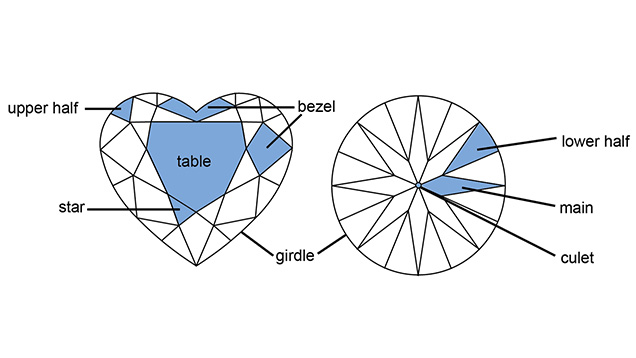Diamond Polish and Symmetry: Guide to GIA Terminology and Abbreviations
Polish Features
Polish is graded on a scale from Excellent to Poor based on the presence and visibility of polish features at 10x magnification. The following features are considered in the polish assessment.| Polish Feature | Abbreviation | Definition | Example |
|---|---|---|---|
| Abrasion | Abr | An area of minute scratches or pits along a facet edge producing a fuzzy white line instead of a sharp facet junction |

|
| Burn |
Brn Dop |
Whitish haze caused by excessive heat during polishing or, occasionally, by a jeweler’s torch is listed as “Brn.” A burn mark caused by excessive heat at the location where the dop touched the diamond is referred to more specifically as “Dop.” |

|
| Laser Manufacturing Remnant | LMR | A remnant of laser manufacturing that remains on the surface of the polished diamond; typically appears as a transparent or white groove; only considered polish when it does not penetrate into the diamond at 10x magnification. |

|
| Lizard Skin | LS | A transparent, uneven texture confined to one facet caused by polishing a facet off-grain |
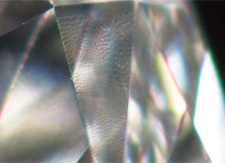
|
| Nick | Nck | A small notch on a facet junction, usually along the girdle or at the culet |

|
| Pit | Pit | A tiny opening appearing as a white dot |

|
| Rough Girdle | RG | An irregular pitted or granular surface of a bruted girdle due to pits and nicks |

|
| Scratch | Scr | A surface mark, normally seen as a fine white line that may be curved or straight |

|
| Polish Lines |
Wht TP Drag line Polish mark |
Parallel lines left by the polishing process; may appear white (Wht) or transparent (TP). A heavy transparent polish line off a surface-reaching feature is referred to more specifically as a "drag line". A surface feature made during the polishing process that resembles an extra facet without a distinct or straight facet junction is referred to as a "polish mark". |
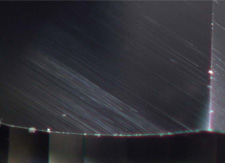 A surface feature made during the polishing process that resembles an extra facet without a distinct or straight facet junction is referred to as a "polish mark"." title="Parallel lines left by the polishing process; may appear white (Wht) or transparent (TP). A heavy transparent polish line off a surface-reaching feature is referred to more specifically as a "drag line". A surface feature made during the polishing process that resembles an extra facet without a distinct or straight facet junction is referred to as a "polish mark"." /> 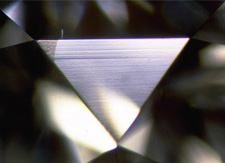
|
Polish Feature Locations
The location of each polish feature is specified using the following terms.| Location | Abbreviation |
|---|---|
| Bezel Facet | bez |
| Chevron Facet | chevron |
| Crown Corner Step Facet | crown corner step |
| Crown | crown |
| Crown Facet | crown facet |
| Crown Step Facet | crown step |
| Culet | culet |
| Girdle | girdle |
| Half-Moon Facet | half-moon |
| Lower Half Facet | l.h. |
| Pavilion Main Facet | main |
| Pavilion | pav |
| Pavilion Corner Step Facet | pav corner step |
| Pavilion Facet | pav facet |
| Pavilion Step Facet | pav step |
| Star Facet | star |
| Table Facet | table |
| Upper Half Facet | u.h. |
Examples:
Symmetry Features
Symmetry is graded on a scale from Excellent to Poor based on the presence and visibility of symmetry deviations at 10x magnification. The following features are considered in the symmetry assessment.
| Symmetry Feature | Abbreviation | Definition | Example |
|---|---|---|---|
| Crown Angle Variation | CV | Unequal crown angles |

|
| Crown Height Variation | CHV | Girdle plane not parallel to the table causing uneven crown height |
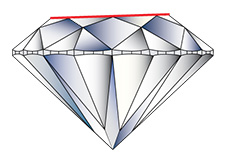
|
| Culet Off-Center | C/oc | Deviation of the culet from the central position on the pavilion |

|
| Extra Facet | EF | Additional facet placed without regard for symmetry and not required by the cutting style |
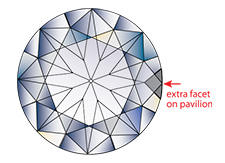
|
| Girdle Thickness Variation | GTV | Variation of the girdle thickness at the bezel-main positions |

|
|
Lower Half Percentage Variation |
LPV | Variation of lower half facet length percentages |
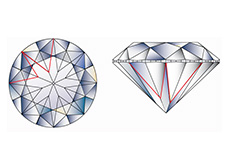
|
| Lower Half Variation | LHV | Unequal lower half facet angles |
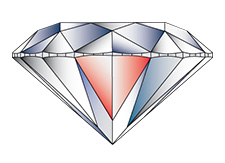
|
| Misalignment | Aln | Displacement of the crown and pavilion facets in relation to each other |

|
| Misshapen Facet |
Fac MB MS MM |
Difference in shape or size between one facet and another of the same type, or distortion of a given facet; bezel, star and main facets that are misshapen are listed more specifically as misshapen bezel (MB), misshapen star (MS) and misshapen main (MM) |

|
| Missing Facet | MF | Asymmetrically missing facet |

|
| Natural | N | Part of the original rough diamond’s surface that remains on the polished diamond |
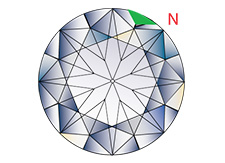
|
| Non-Octagonal Table |
T/oct TEV |
The table of a Round Brilliant is not a regular octagon, showing differences among the four table sizes (T/oct) or among the eight table edges (TEV) |


|
| Non-Pointing |
Ptg SM SB OM OB |
Fully formed facet that does not reach its prescribed location (short facet) or is incompletely finished (open facet), resulting in adjoining facets not meeting at precise points; non-pointing of bezel and main facets are listed more specifically as short main (SM), short bezel (SB), open main (OM) and open bezel (OB) |

|
| Out-of-Round | OR | Deviation from the circular shape of a round diamond |

|
| Pavilion Depth Variation | PDV | Variation of pavilion depth |

|
| Pavilion Angle Variation | PV | Unequal pavilion angles |

|
| Star Percentage Variation | SPV | Variation of star facet length percentages |
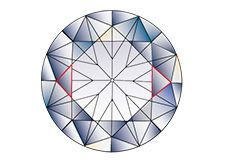
|
| Star Angle Variation | SV | Unequal star facet angles |

|
| Table Off-Center | T/oc | Deviation of the table from the central position on the crown |
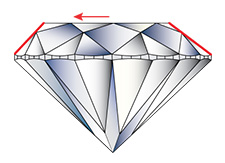
|
| Table/Culet Alignment | T/C | Displacement of the table facet and culet in different directions |

|
| Upper Half Variation | UHV | Unequal upper half facet angles |
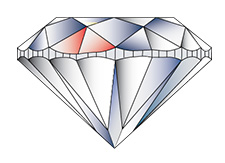
|
| Uneven Outline | UO | Asymmetrical shape outline; also refers to bumps and flattened areas created by a natural, extra facet or uneven girdle faceting on round diamonds |

|
Cumulative
Cumulative is listed under symmetry features when the symmetry grade is based on the combined effect of symmetry features instead of individual deviations. For example, a diamond with pavilion depth variation (PDV) and crown angle variation (CV) that measures on the border of Very Good and Good may receive a lower symmetry grade based on their combined appearance and be represented as “Cumulative: PDV, CV.”
Abbreviations
| Polish Features | |
|---|---|
| Abbreviation | Polish Feature |
| Abr | Abrasion |
| Brn | Burn |
| Dop | Dop Burn |
| LMR | Laser Manufacturing Remnant |
| LS | Lizard Skin |
| Nck | Nick |
| Pit | Pit |
| RG | Rough Girdle |
| Scr | Scratch |
| Wht | White Polish lines |
| TP | Transparent Polish Lines |
| Drag line | |
| Polish mark |
| Symmetry Features | |
|---|---|
| Abbreviation | Symmetry Feature |
| Aln | Misalignment |
| C/oc | Culet Off-Center |
| CV | Crown Angle Variation |
| CHV | Crown Height Variation |
| EF | Extra Facet |
| Fac | Misshapen Facet |
| GTV | Girdle Thickness Variation |
| LHV | Lower Half Angle Variation |
| LPV | Lower Half Percentage Variation |
| MB | Misshapen Bezel |
| MF | Missing Facet |
| MM | Misshapen Main |
| MS | Misshapen Star |
| N | Natural |
| OB | Open Bezel |
| OM | Open Main |
| OR | Out-of-Round |
| PDV | Pavilion Depth Variation |
| Ptg | Non-Pointing |
| PV | Pavilion Angle Variation |
| SB | Short Bezel |
| SM | Short Main |
| SPV | Start Percentage Variation |
| SV | Star Angle Variation |
| T/C | Table/Culet Alignment |
| T/oc | Table Off-Center |
| T/oct | Non-Octagonal Table |
| TEV | Table Edge Variation |
| UHV | Upper Half Angle Variation |
| UO | Uneven Outline |
| Polish Locations | |
|---|---|
| Abbreviation | Polish Location |
| bez | Bezel Facet |
| chevron | Chevron Facet |
| crown corner step | Crown Corner Step Facet |
| crown | Crown |
| crown facet | Crown Facet |
| crown step | Crown Step Facet |
| culet | Culet |
| girdle | Girdle |
| half-moon | Half-Moon Facet |
| l.h. | Lower Half Facet |
| main | Pavilion Main Facet |
| pav | Pavilion |
| pav corner step | Pavilion Corner Step Facet |
| pav facet | Pavilion Facet |
| pav step | Pavilion Step Facet |
| star | Star Facet |
| table | Table Facet |
| u.h. | Upper Half Facet |
| Modifiers* | |
|---|---|
| Abbreviation | Modifier |
| sl | slight |
| fnt | faint |
| hvy | heavy |
| + | multiple |
*Reports for all diamonds graded later than January 30th, 2012 should include only the terminology and abbreviations listed in this document. You may come across non-standardized information on diamonds graded prior to January 30th, 2012 including the use of the modifiers listed in the table above.
“Sl” and “+” were typically applied to both Polish features and Symmetry deviations, while “fnt” and “hvy” were applied exclusively to Polish features. The modifier “+” referred to multiple facets of the same type with a given polish feature, or multiple facets of the same type with a given symmetry deviation (Ex. TP: l.h.+; MM+).
